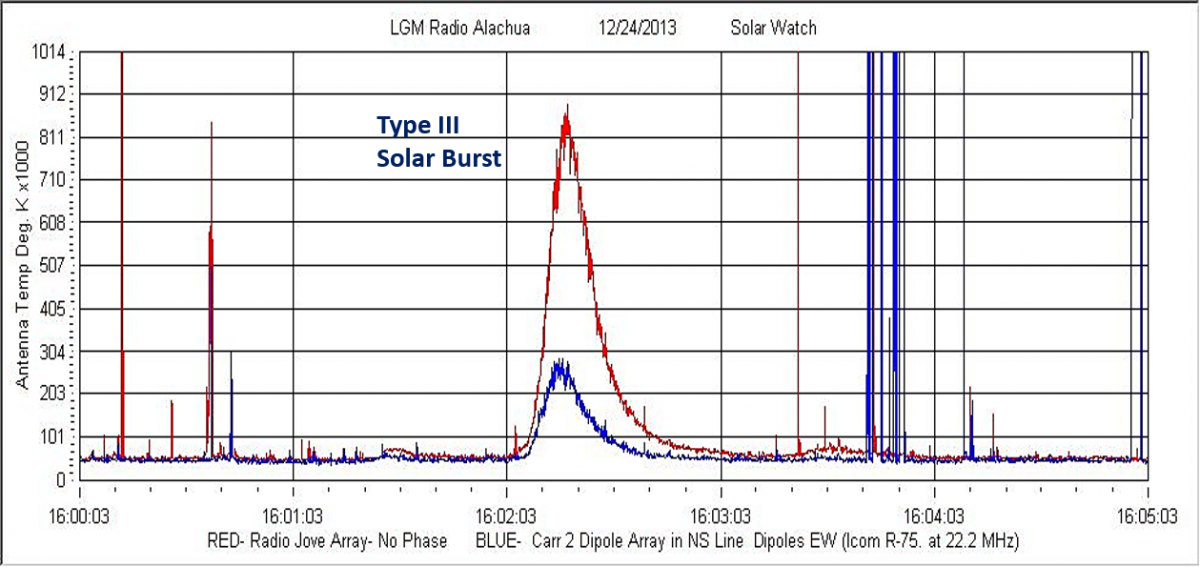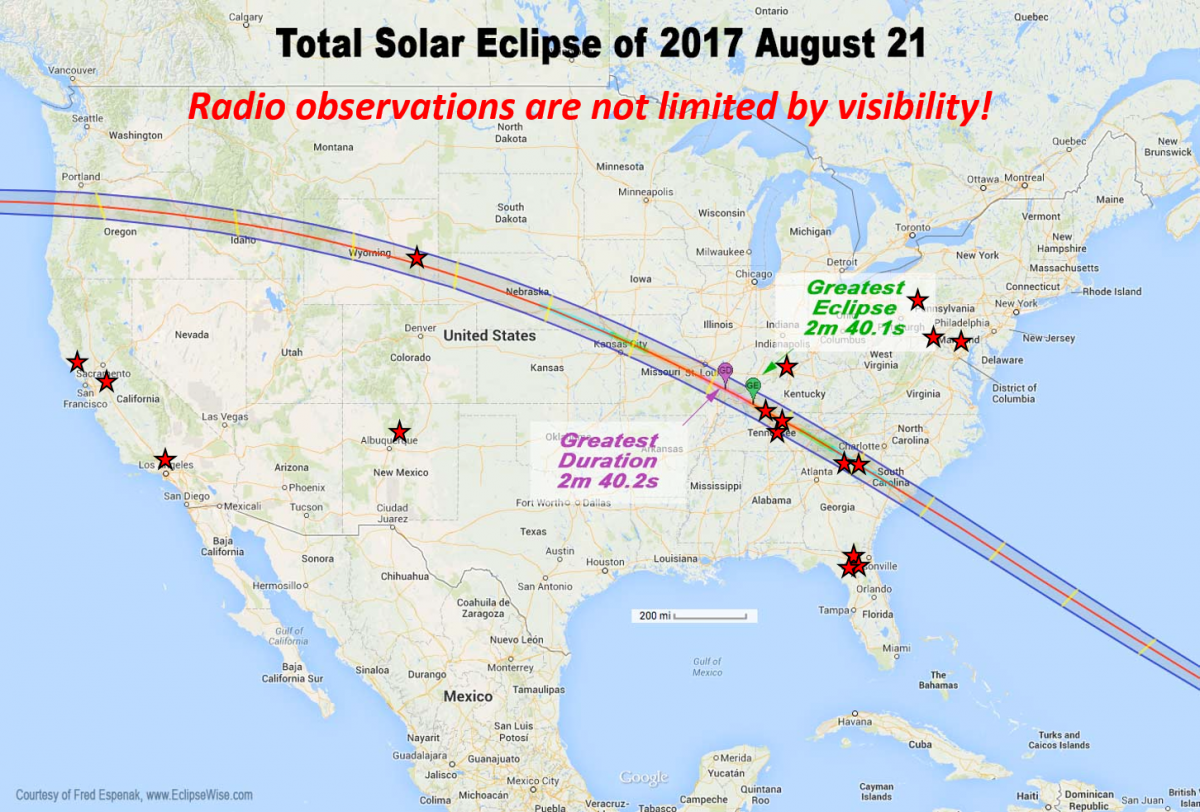The Radio Jove Project and the 2017 Solar Eclipse
The Radio Jove Project and the 2017 Solar Eclipse

By Dr. Chuck Higgins, Middle Tennessee State University
Radio Jove is a NASA-affiliated education and outreach project that began in 1999 and gives students, teachers, and other interested individuals a hands-on experience in learning radio astronomy (http://radiojove.gsfc.nasa.gov). Radio Jove is a not-for-profit organization, led by a team of about eight volunteer scientists and engineers, which provides a mechanism to distribute radio telescope education kits and educational resources. Participants may build a simple radio telescope kit, make scientific observations, and interact with professional radio observatories in real-time over the Internet. Dedicated observers can help answer science questions about the nature and characteristics of low frequency radio emissions coming from Jupiter and the Sun, as well as, to understand the variability of Earth’s ionosphere. Radio Jove maintains a data archive to facilitate in the exchange of information and the validation of other ground-based and space-based radio data.
Due to the nature of its magnetic field, Jupiter emits cyclotron radio wave frequencies below 40 MHz, and more precipitously at lower frequencies. The best frequency range to study Jupiter with ground-based telescopes is above the ionospheric cutoff at about 15 MHz and below 30 MHz. The Sun is also a strong, sporadic non-thermal radio emitter at these frequencies (Figure 1). Because this frequency range overlaps the ham radio bands, Jupiter and solar radio astronomy may be of keen interest to some of the ham radio community.

Figure 1. This is a typical type III solar radio burst observed (red line) at 20.1 MHz with a Radio Jove telescope and (blue line) at 22.2 MHz using an ICOM R-75 receiver and a set of two aluminum dipoles. The data are plotted as intensity (antenna temperature, Kelvin) versus time on Dec 24, 2013. [Credit: W. Greenman]
On August 21, 2017, the Great American Eclipse of 2017 will take place. The moon will pass directly between the Earth and the Sun and the shadow of the moon will follow a path across the continental United States from Oregon to South Carolina. There are many websites describing this amazing phenomenon, and the website https://eclipse2017.nasa.gov provides a great list of general information, eclipse science, observing events, and educator resources.
Radio Jove is engaging citizen scientists during the 2017 solar eclipse by encouraging them to observe the solar eclipse with radio telescopes. We will enlist and train observers from across the US to help with deployment of the telescopes at different locations along the eclipse path of totality and at other locations receiving a partial eclipse (Figure 2). During the approximately 4-hour event (with totality lasting only ~2.5 min), the 120 km-diameter umbra and the larger penumbra of the moon will sweep across the continental United States. Radio observers will monitor the Sun for solar flares and radio events during the solar eclipse, as well as, observe the galactic radio background (GRB) before, during, and after the eclipse. We will make most observations over a narrow frequency range centered on 20.1 MHz, and several advanced observers will operate spectrographs between 15-30 MHz.

Figure 2. Markers indicate planned observation sites for Radio Jove as of February 2017. Radio observations are scientifically useful both inside and outside the path of totality. [Adapted from https://eclipse.gsfc.nasa.gov/SEgoogle/SEgoogle2001/SE2017Aug21Tgoogle.html]
The passage of the moon directly in front of the Sun from the Earth viewpoint means that the Moon will occult or cut off the Sun’s corona and photosphere over about 4 hours. If a solar radio burst were to occur during the time of the eclipse it is possible that the moon will gradually cover over the coronal source region and provide clues to the exact location of the radio source and how it evolves. Observers at different locations on the Earth would see the occultation happening at different times or perhaps not at all depending on their viewpoint. In addition, the umbral and penumbral shadows will temporarily decrease the ionization levels of the terrestrial ionosphere above, thus causing less absorption of the galactic radio background (GRB) over the eclipsed areas during daylight hours. Thus, the total solar eclipse will offer a unique opportunity to study the response of the terrestrial ionosphere, and perhaps determine the ionospheric (F-peak) electron densities. We will analyze the GRB data collected before, during, and after the eclipse at different portions of the eclipse path and compare it to the baseline data obtained in advance. Prior to the eclipse, observations during the night will enable observers to determine the average GRB under the same celestial configuration as during the eclipse but with no ionospheric absorption by the D layer. The baseline will enable us to infer the changing ionospheric conditions during the eclipse over the different observing locations.
In summary we plan to use the radio data to: (1) determine whether a solar radio source was occulted or not, and if so, determine the active source location, (2) measure the amount of ionospheric absorption at various locations within the partial and total phases of the eclipse, and (3) characterize the changes in the terrestrial ionization under different local time conditions. We will archive the data and make it available to the public and scientific community.
For simplicity in hardware setup (portability, cost, reliability, etc.), we will use the basic Radio Jove hardware setup for solar eclipse observations (Figure 3). You can find detailed instructions about the Radio Jove equipment, equipment manuals, and example observations on our website (http://radiojove.gsfc.nasa.gov). Additionally, there are specific Radio Jove solar eclipse observing instructions listed on the website.
The basic equipment required*:
- Radio Jove receiver (tuned near 20.1 MHz)
- 12-volt battery (or 12-volt power supply)
- Radio Jove antenna dipole (or regular dual-dipole setup, about 30 ft. x 30 ft. of space)
- Computer (i.e., laptop with battery, external speakers are optional)
- Radio-Skypipe Software
- Calibrator (recommended to make the data more scientifically useful)
* Ham radio operators may also be able to observe the Sun using existing receivers and/or transceivers and antennas, but only if they can defeat the automatic gain control circuit. If you have specific questions about using ham radio equipment for solar observing, you are welcome to contact the Radio Jove group.

Figure 3. (Top) This is an example of a Radio Jove antenna setup with two dipoles. For solar observations, only one dipole is necessary. (Bottom) The receiver connections and the basic equipment needed for a remote setup. [Credit: The Radio Jove Project]
In general, Radio Jove will always welcome new participants, and we hope that the 2017 solar eclipse will motivate more people to join us. Anyone with a passion for learning can participate in Radio Jove, especially those with some technical skills. Participation can primarily come in 3-4 different ways: (1) buy and build your own Radio Jove receiver and antenna to collect your own Jupiter or solar radio data; (2) use available software, called Radio-Skypipe, to monitor, record, and analyze radio data remotely from another Radio Jove user; (3) download data from the Radio Jove Archive (http://radiojove.org/archive.html); and (4) modify or purchase your own radio equipment to make observations and contribute to the community. Option 2 is particularly useful for schools or people that may not have the space or funding to set up their own telescope. We periodically schedule telecons to help answer questions and foster interactions and data collections during times of predicted Jupiter or solar activity. If you would like more information about our Radio Jove email list, please visit http://radiojove.gsfc.nasa.gov/office/appform.htm.
